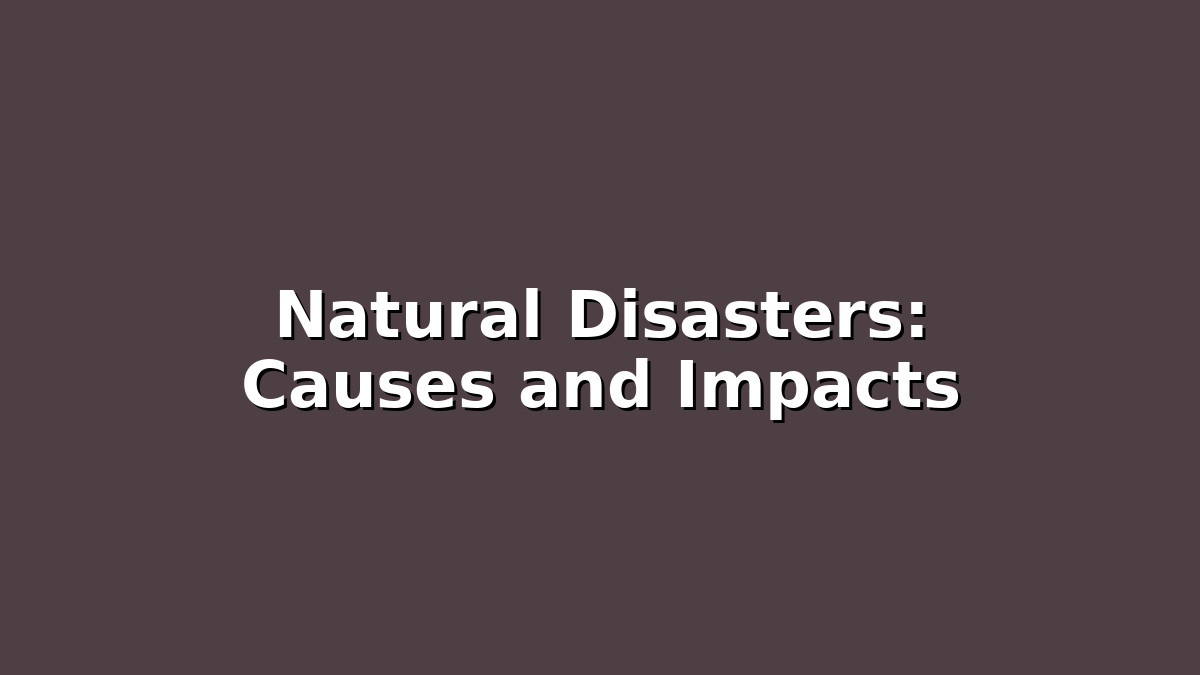Preparing for exams can be stressful, especially when your study materials cover broad and complex topics like natural disasters. Understanding the causes and impacts of natural disasters is not only essential for science or geography exams but also helps you become more aware of the world around you. In this article, we will explore the causes of natural disasters, their impacts on people and the environment, and provide practical study tips to help you grasp the material effectively and confidently.
Understanding the Causes of Natural Disasters
Natural disasters are catastrophic events caused by natural forces of the Earth. These events include earthquakes, hurricanes, floods, volcanic eruptions, tsunamis, and droughts. Each disaster has unique causes, but often they are linked to the dynamic processes within the Earth or atmospheric conditions.
– Tectonic Activity: Earthquakes and volcanic eruptions result from movements of the Earth’s tectonic plates. When plates shift suddenly, they release energy that causes earthquakes. Similarly, magma rises through cracks, causing volcanic eruptions. Understanding plate tectonics is crucial in grasping why these disasters occur.
– Weather Patterns: Hurricanes, tornadoes, and floods largely depend on atmospheric conditions such as temperature, humidity, and pressure changes. Warm ocean waters fuel hurricanes, while excessive rainfall can lead to floods.
– Climate Conditions: Droughts and wildfires are often the result of prolonged dry weather and high temperatures. These conditions reduce water availability, impacting agriculture and ecosystems.
Study Tip: To remember these causes, create flashcards with the name of the disaster on one side and its causes on the other. Use diagrams, like the Earth’s plate boundaries or the water cycle, to visually link cause and effect. Visual learning helps in retaining complex information and makes revision more engaging.
Examining the Impacts of Natural Disasters
Natural disasters can have devastating effects on human lives, economies, infrastructure, and the environment. Recognizing these impacts is vital for understanding their significance in exam questions and essays.
– Human Impact: Loss of life, injuries, displacement, and psychological trauma are among the most tragic consequences. For example, a major earthquake can leave thousands homeless, while a flood can contaminate drinking water sources, leading to disease outbreaks.
– Economic Impact: Natural disasters often cause billions of dollars in damages. They destroy homes, businesses, roads, and bridges, disrupting daily life and economic activities. Recovery and rebuilding efforts can take years and require heavy investment.
– Environmental Impact: Ecosystems suffer as forests burn or floodplains are submerged. Animal habitats are destroyed, soil quality deteriorates, and long-term changes in land use can occur. Volcanic eruptions can also enrich soils with minerals, which shows that impacts can sometimes be positive in the longer term.
Study Tip: When studying impacts, use real-world case studies to connect theory with reality. For example, look at the 2010 Haiti earthquake or the 2004 Indian Ocean tsunami. Summarize key facts, impacts, and recovery efforts. Writing short paragraphs or bullet points will help you organize information clearly for essays and exams.
How to Effectively Study Natural Disasters for Exams
Studying natural disasters can feel overwhelming due to the variety of events and their complex nature. However, adopting the right strategies can help you study efficiently and improve your understanding.
– Break Down the Topic: Divide the subject into smaller sections like causes, types, impacts, and prevention. Focus on one section at a time to avoid information overload.
– Use Mind Maps: Create mind maps that link different types of disasters with causes and impacts. This visual tool helps you see the connections and organize your thoughts logically.
– Practice Past Papers: Attempt past exam questions related to natural disasters. This not only tests your knowledge but also familiarizes you with the question format and helps with time management.
– Teach Someone Else: Explaining what you’ve learned to a friend or family member reinforces your understanding. Teaching requires you to simplify concepts, which aids memory retention.
– Stay Updated: Natural disasters frequently feature in news reports. Following current events can provide additional examples and make your answers more relevant and interesting.
Study Tip: Set specific goals for each study session, such as “Today, I will learn the causes of earthquakes and volcanoes.” Use timers like the Pomodoro technique (25 minutes study, 5 minutes break) to maintain focus and avoid burnout.
Conclusion
Natural disasters are powerful events shaped by natural forces, affecting millions of lives and altering environments worldwide. As students, understanding their causes and impacts not only prepares you for exams but also broadens your awareness of global challenges. Remember to break down complex information, use visual aids like flashcards and mind maps, and practice with real exam questions to deepen your knowledge. Stay curious and confident in your study approach—you’re building skills that will help you succeed in exams and beyond.
Keep going, and don’t hesitate to revisit topics multiple times. Consistency is key to mastering any subject!

Responses